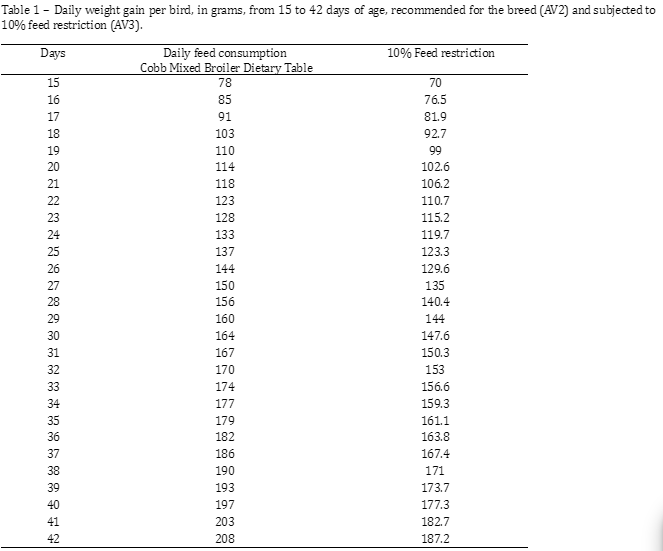Economic and productive performance of broilers subjected to quantitative feed restriction
DOI:
https://doi.org/10.21708/avb.2024.18.2.12410Resumo
Nutrition today accounts for approximately 75% of broiler production costs due to the large variety of ingredients contained in poultry feed. Commercial chicken breeds have been genetically selected for rapid weight gain, among other characteristics, thereby stimulating their voracious feeding behavior. However, this greater feed intake has not seen an attendant increase in the digestion capacity of the birds’ digestive system, thus interfering with feed conversion. The objective of this study to compare the performance of feed conversion, mortality rates, daily weight gain, carcass rejections, carcass and parts yields and the cost of ad libitum feeding of broiler chickens with those achieved through quantitative feed restriction (Cobb broiler diet table and 10% less than recommended in the table). The treatments were tested in three consecutive batches on a poultry farm with three aviaries. The results obtained indicated that quantitative feed restriction improves feed conversion and reduces daily weight gain and mortality rates, but affects neither carcass rejection rates nor carcass and parts yields. As for production costs, the kilogram of live chicken was 5.69% lower among birds that received controlled feed, following the diet recommended for the breed, and 7.38% in birds that received a 10% quantitative feed restriction compared to the Cobb broiler diet table. The results of this study indicate that the use of quantitative feed restriction programs, despite the lower daily weight gain of broiler chickens, can offer advantages because lower mortality rates and enhanced feed conversion compensate for this loss, thus significantly reducing production costs.
Downloads

Downloads
Publicado
Edição
Seção
Licença
Copyright (c) 2024 Acta Veterinaria Brasilica

Este trabalho está licenciado sob uma licença Creative Commons Attribution 4.0 International License.
Autores que publicam na Acta Veterinaria Brasilica concordam com os seguintes termos: a) Autores mantém os direitos autorais e concedem à revista o direito de primeira publicação, com o trabalho simultaneamente licenciado sob a Licença Creative Commons Attribution que permite o compartilhamento do trabalho com reconhecimento da autoria e publicação inicial nesta revista. b) Autores têm autorização para assumir contratos adicionais separadamente, para distribuição não-exclusiva da versão do trabalho publicada nesta revista (ex.: publicar em repositório institucional ou como capítulo de livro), com reconhecimento de autoria e publicação inicial nesta revista. c) Autores têm permissão e são estimulados a publicar e distribuir seu trabalho online (ex.: em repositórios institucionais ou na sua página pessoal) a qualquer ponto antes ou durante o processo editorial, já que isso pode gerar alterações produtivas, bem como aumentar o impacto e a citação do trabalho publicado (Veja O Efeito do Acesso Livre).


 Esta obra está licenciada com uma Licença
Esta obra está licenciada com uma Licença 